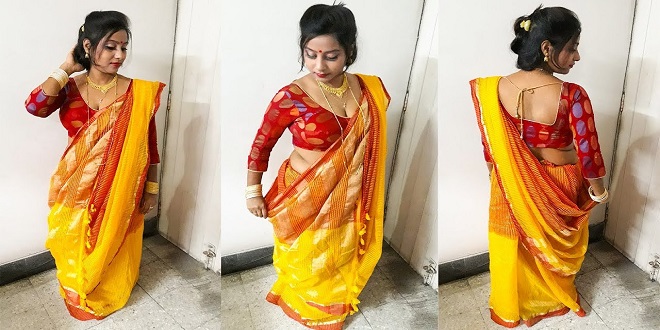Saree Draping – The Cozy Indian Art

Your saree needs to be perfectly draped to accentuate your beauty. Art, indeed! Every Indian state has a distinctive culture that contributes to the diversity of saree draping patterns. The saree draping style changes along with the variations in the saree’s designs.
Don’t you want to experiment with various drapes? You would for sure! You can see numerous artworks such as Bandhani, Madhubani print, block printing, Kashmiri Aari work, Gota Patti, kamdani, and so on, all over the saree. The draping is also influenced by the fabric’s clinginess and texture. As an illustration, sarees made of crepe silk would have a slightly scratchy texture yet have good saree draping.
Pleated Saree Draping
One of the most typical saree draping we see is the pleated saree draping. Pleated drapes look great in both heavy designer sarees and bridal Kanjeevaram sarees. However, cotton sarees are the most sought-after saree for a pleated saree draping. Nobody can dispute the magnificence that a high neck blouse and pleated cotton saree can provide.
Casual Saree draping
The simplest drape to have and pull off is this one. All types of sarees, including pattu, lightweight, and net varieties, can be draped carelessly with the pallu fastened by a pin or brooch. This could be a terrific choice of saree draping for a wedding guest saree because it will make you look relaxed and at ease in those thick sarees. Try draping a saree made of thin fabric, such as chiffon, georgette, or net, behind open blouses or blouses with zippers. Blouses with the front left open do not look nice.
Saree draping in Gujarati Style
Even though it is typically worn by Gujarati women, the Gujarati style saree draping is a popular option for many. These have become popular for bridal sarees with either a short or long pallu. Banarasi, Patola, Bhandini, or Leharia sarees with a short pallu are recommended for this saree draping.
Pant Style saree draping
The trouser style saree draping is a popular fashion trend that is dominating the charts. Fashionable and simple to wear. Ideal for wearing as cocktail attire and reception sarees for wedding guests. This would be an option for mehendi as a bride.
Bengali Saree Draping
Several movies, like Devdas, Kahani, and Gunday, have had a significant impact on Bengali sarees. Additionally, the unusual way of Bengali saree draping makes Bengali women look even more beautiful. This presents an authentic and elegant image. However, the initial drape can be found in a similar manner. Only the front side of this saree has changed.
Five alternative techniques to make a Bengali-style saree step by step
Bengali saree draping is quite straightforward and easy in contrast to other saree drapes. There are numerous different ways to drape a saree in India, including the Nivi, Gujarati, Marathi, and many others. The most beautiful drape, however, is the Bengali saree. The Bengali saree is also the cosiest type of saree, and it gives women a stunning appearance. Additionally, you can carry it for a very long time.
Step by Step Bengali Saree Draping in the Aatpoure Style
The original Bengali term for draping is “aatpoure,” which translates to “eightfold.” The Garad saree is typically worn by Bengali women. The steps involved in Bengali saree draping are as follows:
Step 1: Wrap the saree around your waist from the right side to the left.
Step 2: Pleat the saree simply and tuck it in at the waist in the Nivi fashion.
Step 3: Pull the remaining saree taut and fold it into flaps to cover the top torso.
Step 4: The final step is to simply attach the pleats to the left shoulder.
Step 5: The pallu stays for a while here. Place the pallu on the right shoulder by making pleats on the tip while holding it. This pallu will now fall under the right hand and form a lovely cowl in the back.
Step 6: Bengali women typically use keys to tie a knot on the tip. The most beautiful way to wear a Bengali saree is this way.




